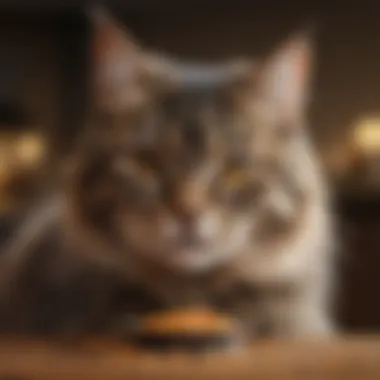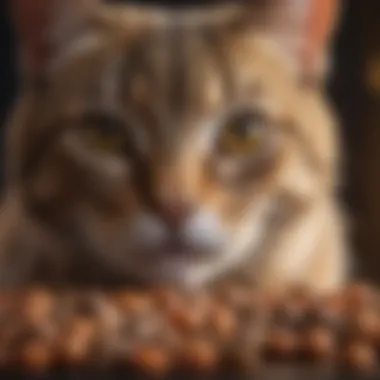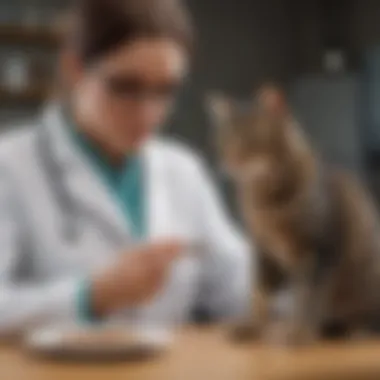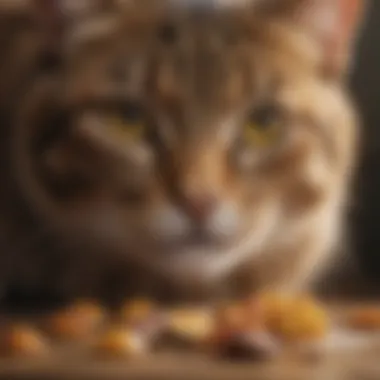Cat Food for Runny Poop: Effective Solutions & Insights


Understanding underlying health problems is just as important as modifying your cat's diet to alleviate gastrointestinal issues.
Understanding the Problem of Runny Poop in Cats
Runny poop in cats is a topic that requires attention from both pet owners and professionals. Understanding this issue goes beyond just recognizing a symptom; it involves a comprehensive insight into a cat's overall health. A cat's stool consistency can serve as an indicator of internal health, diet effectiveness, and emotional well-being. Runny stools, medically known as diarrhea, can complicate a cat's digestive processes, leading to dehydration and malnutrition if not addressed properly. Thus, understanding the problem is vital for the long-term care of cats.
Definition and Symptoms
Runny poop can manifest as soft, liquid, or loose stools that do not hold shape. It's crucial to observe a cat's litter box habits. Signs that typically accompany runny poop include frequent trips to the litter box, straining, or defecating more than usual. A cat may also show signs such as lethargy, vomiting, or decreased appetite. Monitoring these symptoms helps owners detect changes early and take timely action.
Common Causes
Multiple factors can contribute to the issue of runny poop in cats. Understanding these causes allows owners to make informed decisions, including diet adjustments.
Food allergies
Food allergies are a significant contributor to digestive disturbances. When a cat's immune system misidentifies a food component as harmful, it can lead to gastrointestinal upset. Common allergens include beef, dairy, and fish. Recognizing food allergies is essential since it can help eliminate specific ingredients that may trigger a negative response. Unfortunately, identifying allergies can take time and involves trial and error.
Infections
Infections, whether viral, bacterial, or parasitic, can lead to diarrhea in cats. They compromise the intestinal lining, impacting nutrient absorption. Feline panleukopenia and salmonella are instances of infections causing severe gastrointestinal upset in cats. Ensuring timely vaccinations can mitigate the risk of infections, but understanding their potential impact is crucial for pet owners.
Parasites
Parasites like worms can lead to digestive issues in cats. These organisms inhabit a cat's intestines and consume the nutrients meant for the host. Symptoms often include weight loss, vomiting, and runny poop. Regular check-ups and fecal tests can help catch parasitic infestations before they worsen. Ensuring proper preventative treatments can alleviate this specific cause.
Stress factors
Cats are sensitive creatures, and stress factors can lead to gastrointestinal disturbances. Changes in environment, introduction of new pets, or lack of routine can trigger stress and result in runny poop. Understanding a cat's emotional needs plays an essential role in managing their health. A calm environment and predictable schedule can mitigate stress-related digestive issues.
When to Consult a Veterinarian
If a cat experiences runny poop for more than a day or two or exhibits other concerning symptoms, consulting a veterinarian is crucial. Persistent diarrhea can lead to dehydration, which can be life-threatening if not addressed promptly. Moreover, a veterinarian can provide a proper diagnosis, which is essential for effective treatment. Timely intervention is key to ensuring a cat's vitality and well-being.
The Role of Diet in Digestive Health
Diet plays a crucial role in the digestive health of cats. At its core, the right diet can significantly mitigate problems like runny poop. A well-balanced diet ensures essential nutrients are provided, aiding not only digestion but also the overall well-being of your feline. This understanding helps cat owners make informed food choices, especially when faced with digestive issues.
How Diet Impacts Digestive Function
The food cats consume impacts their gut health directly. Cats are obligate carnivores; they thrive on animal proteins. Poor food choices can lead to digestive upsets, resulting in symptoms such as diarrhea. Ingredients in commercial foods, like artificial fillers or low-quality proteins, can disrupt normal digestion. In contrast, high-quality food, rich in digestible nutrients, can enhance gut function.
Key Nutritional Components
Proteins and digestibility
Proteins are vital for overall health and particularly important for digestion. High-quality proteins enhance digestibility, which is crucial for cats with sensitive stomachs. When proteins are easily digestible, cats absorb more nutrients. If proteins are from low-quality sources, they can lead to digestive issues. Thus, a focus on digestibility is essential when choosing a cat food product.
Fiber types and their importance


Fiber plays a significant role in maintaining digestive health. It helps regulate bowel movements and can alleviate issues like diarrhea. There are two main fiber types: soluble and insoluble. Soluble fiber absorbs water, forming a gel-like substance, while insoluble fiber adds bulk to the stool. Including fiber in a cat's diet aids in proper digestion, making it a beneficial consideration when selecting cat food.
Fats and fatty acids
Fats and fatty acids are essential for energy and skin health. They also play a role in digestion by assisting in nutrient absorption. Healthy fats, such as omega-3 and omega-6 fatty acids, can improve gut health and reduce inflammation. However, excessive fat can lead to gastrointestinal upset, so balance is vital. Choosing cat food with the right type and amount of fats is crucial for digestive health.
A balanced diet, rich in digestible proteins, fiber, and healthy fats, can help prevent and address issues like runny poop in cats.
In summary, understanding the role of diet in digestive health is key. Proper nutritional choices can alleviate digestive issues and contribute to a cat's overall well-being.
Types of Cat Food Suitable for Runny Poop
Selecting the right cat food plays a crucial role in managing your cat's digestive health. For cats experiencing runny poop, the appropriate diet can significantly reduce gastrointestinal disturbances. Understanding the types of foods that cater to sensitive digestive systems helps pet owners formulate better feeding strategies, potentially improving their pets' overall well-being. There are two primary categories to consider: commercial cat foods and homemade dietary solutions. Each has its unique benefits and considerations that can influence a cat's digestive comfort.
Commercial Cat Foods
Formulated for sensitive stomachs
Cat food designed for sensitive stomachs usually contains easily digestible proteins and limited fillers. These formulas aim to minimize irritation in the gastrointestinal tract. This type of food is often a beneficial choice because it caters specifically to those cats prone to digestive issues. Since many of these products feature high-quality ingredients, they tend to offer better nutrient absorption, reducing the likelihood of runny poop. However, it is essential to note that not all brands guarantee quality. Some may include unnecessary additives that could counteract the benefits.
Limited ingredient diets
Limited ingredient diets (LIDs) focus on a few select components, aiming to reduce the risk of food allergies and sensitivities. The main characteristic of these diets is their simplicity; by using fewer ingredients, they can identify problematic foods and manage diarrhea effectively. LIDs are popular among pet owners seeking to pinpoint specific food intolerances. The unique aspect can be both a strength and a weakness. While they allow more straightforward tracking of reactions to food, they might not provide complete nutrition if not well-balanced.
High-fiber options
High-fiber cat foods support digestive health by improving stool quality. The presence of various fiber types aids in stool formation and can help prevent runny poops. These foods are particularly valued for their ability to slow down digestion, which can be helpful for cats that experience loose stools or irregular bowel movements. While high-fiber diets can be a great solution, some cats may initially experience bloating or gas as they adjust to an increase in fiber, so gradual introduction is essential.
Homemade Diet Solutions
Poultry and rice recipes
Poultry and rice form a classic standard in homemade diets for cats. This combination provides a balanced source of proteins and carbohydrates that are gentle on the stomach. This simple recipe is a beneficial choice, especially when transitioning from commercial food to homemade. Its ease of preparation allows for control over ingredient quality while closely monitoring reactions to food. However, creating a fully balanced meal can be challenging without proper knowledge, and relying solely on chicken and rice might not supply all necessary nutrients in the long run.
Pumpkin and its benefits
Pumpkin is a well-known home remedy for digestive issues in cats. It is rich in fiber, which aids in forming firm stools while also being low in calories. The key characteristic of pumpkin is its ability to bind with excess moisture in the intestines, helping alleviate diarrhea. Additionally, its high water content provides hydration. Despite its palatability, some cats may be hesitant to consume pumpkin, requiring owners to experiment with mixing it into other foods.
Balancing homemade diets
Balancing homemade diets is crucial for ensuring that cats receive all necessary nutrients. It involves understanding the right carbohydrate-to-protein ratio and including essential vitamins and minerals. This aspect is especially important within the broader context of managing digestive health. Properly balanced diets can improve nutrient availability and minimize digestive disturbances. However, achieving this balance requires careful planning and research, as an unbalanced homemade diet can lead to nutritional deficiencies.
“Feeding a cat is not just about providing food; it’s about understanding their unique needs based on health and activity level.”
By exploring both commercial and homemade options, cat owners can make informed choices that directly impact their cat's digestive health. Preparing appropriate meals based on these factors ensures that cats are not only satisfied but also healthier in the long term.
Identifying Food Sensitivities in Cats
Understanding food sensitivities in cats is pivotal for ensuring their digestive health. When your cat experiences runny poop, it may be a result of food allergies or intolerances. Identifying these sensitivities can help tailor your cat's diet to avoid certain ingredients, ultimately improving their overall health and comfort. This section seeks to inform cat owners about the signs of food allergies and how to use elimination diets effectively as a strategy to pinpoint problem foods.
Signs of Food Allergies


Recognizing the signs of food allergies in cats can be tricky. Some common symptoms include:
- Frequent vomiting
- Abdominal pain or discomfort
- Changes in stool consistency, such as runny stools
- Skin irritations, itching or excessive grooming
- Loss of appetite or weight loss
If you observe these signs, it is crucial to take them seriously. Food allergies can lead to further digestive issues if not addressed. Monitoring your cat’s reactions to specific foods will help you ascertain what may be affecting their digestive health.
Elimination Diets Explained
What is an elimination diet?
An elimination diet involves removing potential allergens from your cat's food for a specific period. The purpose is to identify foods that may cause adverse reactions. The key characteristic of this approach is its systematic nature, which allows for controlled reintroduction of ingredients to spot triggers. These diets are beneficial because they provide a structured framework for understanding how different foods affect your cat’s digestive system.
A unique feature of an elimination diet is that it often includes limited ingredients, which reduces the chances of unintentional exposure to allergens. However, it requires diligence from pet owners to maintain consistency and careful observation throughout the process.
How to properly conduct one
To conduct an elimination diet effectively, follow these key steps:
- Select a suitable diet: Choose a high-quality, limited-ingredient cat food or a homemade meal plan that excludes all common allergens.
- Duration: Maintain the elimination diet for a minimum of 8 to 12 weeks to see any potential changes.
- Observe closely: Keep track of any changes in your cat's health during this period.
The main characteristic of this process is patience. It can be frustrating to wait for results, but this is essential for accurate identification of sensitivities. A well-executed elimination diet can reveal which foods to avoid, thereby improving your cat's health in the long run.
Evaluating results and adjustments
After the elimination period, it's time to evaluate the findings. You may gradually reintroduce one food at a time and monitor your cat's response. Key characteristics to consider include:
- Timeframe: Introduce new ingredients every few days to pinpoint culprits clearly.
- Documentation: Keeping a detailed food diary will help track changes in symptoms.
Evaluating results can be both enlightening and frustrating. A successful elimination diet will often lead to noticeable improvements in your cat's digestive health and well-being. Furthermore, understanding their sensitivities can help you make informed decisions regarding their diet moving forward.
Knowing and managing food sensitivities in your cat is vital in preventing future digestive issues and ensuring a healthier life.
Assessing Ingredients in Cat Food
Understanding the ingredients in cat food is crucial for addressing digestive issues like runny poop. The right elements in a diet can enhance a cat's digestion and overall health. This section will outline how to analyze cat food ingredients effectively and highlight certain components to be mindful of for optimal digestive function.
Understanding Labeling Practices
Cat food labels can be confusing. Often, companies use marketing tactics that might not align with nutritional value. Familiarizing yourself with labeling practices is essential. First, look for quality assurance statements. Terms like "complete and balanced" indicate the food meets AAFCO standards. Ingredients should be listed in descending order by weight. This means the first few listed are the predominant components of the diet. Ingredients can be vague, such as "meat." Always prefer items with specified meat sources, such as chicken or beef, which indicate quality and digestibility.
Ingredients to Avoid
Being aware of harmful ingredients can help you make better choices for your cat's health. Here are several categories to eliminate from consideration:
Artificial fillers
Artificial fillers serve to bulk up cat food but lack nutritional value. They can contribute to poor digestion and lead to gastrointestinal issues. These fillers may include cellulose or corn gluten meals. Not nutritious, they can cause allergies in sensitive cats. Avoiding artificial fillers helps ensure that your cat receives essential nutrients necessary for their health.
Low-quality protein sources


Low-quality protein sources, such as by-products, are often less digestible than high-quality proteins. They can stem from various animal parts that might not provide sufficient amino acids. These proteins might lead to nutritional deficiencies over time, impacting your cat's vitality. Focusing on whole meat sources will better support your cat's digestive health and boost energy.
Excessive grains
Grains may serve as fillers in some cat foods. Cats are obligate carnivores, meaning their diet should consist mostly of meat. Excessive grains can lead to digestive distress, contributing to softer stools and health issues. Minimizing grain content ensures your cat receives the right nutrients without unnecessary fillers that do not serve a beneficial purpose.
By being proactive and assessing the ingredients in cat food, you can support your cat’s digestive health and reduce issues like runny poop.
Understanding these factors empowers pet owners to make informed dietary choices, directly impacting their feline friends' wellbeing.
Monitoring Your Cat's Health
Monitoring your cat's health is a crucial aspect of understanding and managing issues such as runny poop. A keen observation of your pet's behavior, eating habits, and bathroom patterns can provide valuable insights. This is particularly important when dealing with sensitive digestive systems that can result from certain foods or other environmental factors.
Being attentive to changes in your cat's health can facilitate early detection of potential problems. Such proactive measures often lead to more effective solutions before conditions worsen. Maintaining a close watch on your cat's health is like keeping a pulse on their overall well-being. It helps pet owners to make informed decisions about dietary changes and when to seek veterinary assistance.
Keeping a Food Diary
A food diary serves as an important tool for understanding your cat's dietary triggers. Keeping track of what your cat eats on a daily basis allows you to identify patterns related to their digestive health. For instance, if runny poop occurs following specific meals, you might pinpoint a problematic ingredient or type of food.
In the food diary, note the following:
- Meal times: Document when you feed your cat and the quantity.
- Food type: Include details about commercial brands or homemade recipes.
- Symptoms: Track any gastrointestinal disturbances in relation to their meals, especially incidents of runny poop.
Over time, this record can help establish a direct connection between diet and health. Recognizing these patterns enables you to adjust meals accordingly or have valuable information ready for your veterinarian.
Regular Vet Check-Ups
Regular veterinary check-ups are vital for maintaining your cat's health. A veterinarian can provide insights and recommendations that can lead to a better understanding of your cat's digestive issues. They can assess your pet's overall health, check for underlying conditions, and monitor any changes in weight or body condition, which might not be apparent to the owner.
During these check-ups, the vet may:
- Examine overall health: Physical exams can reveal problems not immediately evident.
- Conduct tests: Blood tests or stool samples can help identify infections, parasites, or food sensitivities.
- Review dietary practices: Discuss your food diary findings to evaluate the efficacy of your current diet.
Building a trusted relationship with your veterinarian ensures that your cat receives tailored care, ultimately supporting better digestive health and well-being.
Finale
The issue of runny poop in cats is more than a mere inconvenience; it signifies an underlying disruption in digestive health. This article underscores the intricate relationship between diet and gastrointestinal function. A comprehensive understanding of how food choices can influence a cat's digestive system is crucial for pet owners.
In summary, a well-balanced diet, tailored to meet the specific nutritional needs of cats experiencing digestive issues, is paramount. Key components such as proteins, fiber, and fats play essential roles in building a resilient digestive system. It is important to evaluate commercial cat foods, especially those marketed as suitable for sensitive stomachs, while also considering homemade solutions that can incorporate digestive-friendly ingredients like pumpkin.
Dietary modifications are often the first step in addressing gastrointestinal disturbances.
Understanding food sensitivities can also guide cat owners towards more appropriate food choices. Keeping a food diary and working alongside a veterinarian are effective strategies for monitoring and improving your cat's digestive health. Regular vet check-ups further complement dietary management, serving to catch any ongoing issues before they escalate.
Overall, it is evident that appropriate dietary interventions can alleviate the discomfort associated with runny poop in cats. By recognizing the signs and adhering to the recommendations presented, pet owners can significantly enhance their cats’ quality of life.
Summary of Key Points
- Runny poop in cats signifies a need for dietary reassessment.
- Proteins, fibers, and fats are crucial for digestive health.
- Types of cat food, including commercial options and homemade recipes, can address digestive issues.
- Identifying food allergies is vital for effective dietary planning.
- Consulting veterinarians ensures informed and safe choices regarding your cat's food.
Next Steps for Cat Owners
To address digestive issues in cats, owners should:
- Evaluate current diet and identify potential triggers.
- Introduce cat foods designed for sensitive stomachs, such as Hill's Science Diet or Blue Buffalo.
- Consider incorporating homemade recipes with easy-to-digest ingredients, focusing on proteins like chicken or turkey and adding fiber such as pumpkin.
- Monitor changes in your cat’s behavior and health through a food diary, noting any improvements or recurring issues.
- Make an appointment with a veterinarian to discuss findings and receive professional guidance tailored to your cat's specific needs.







